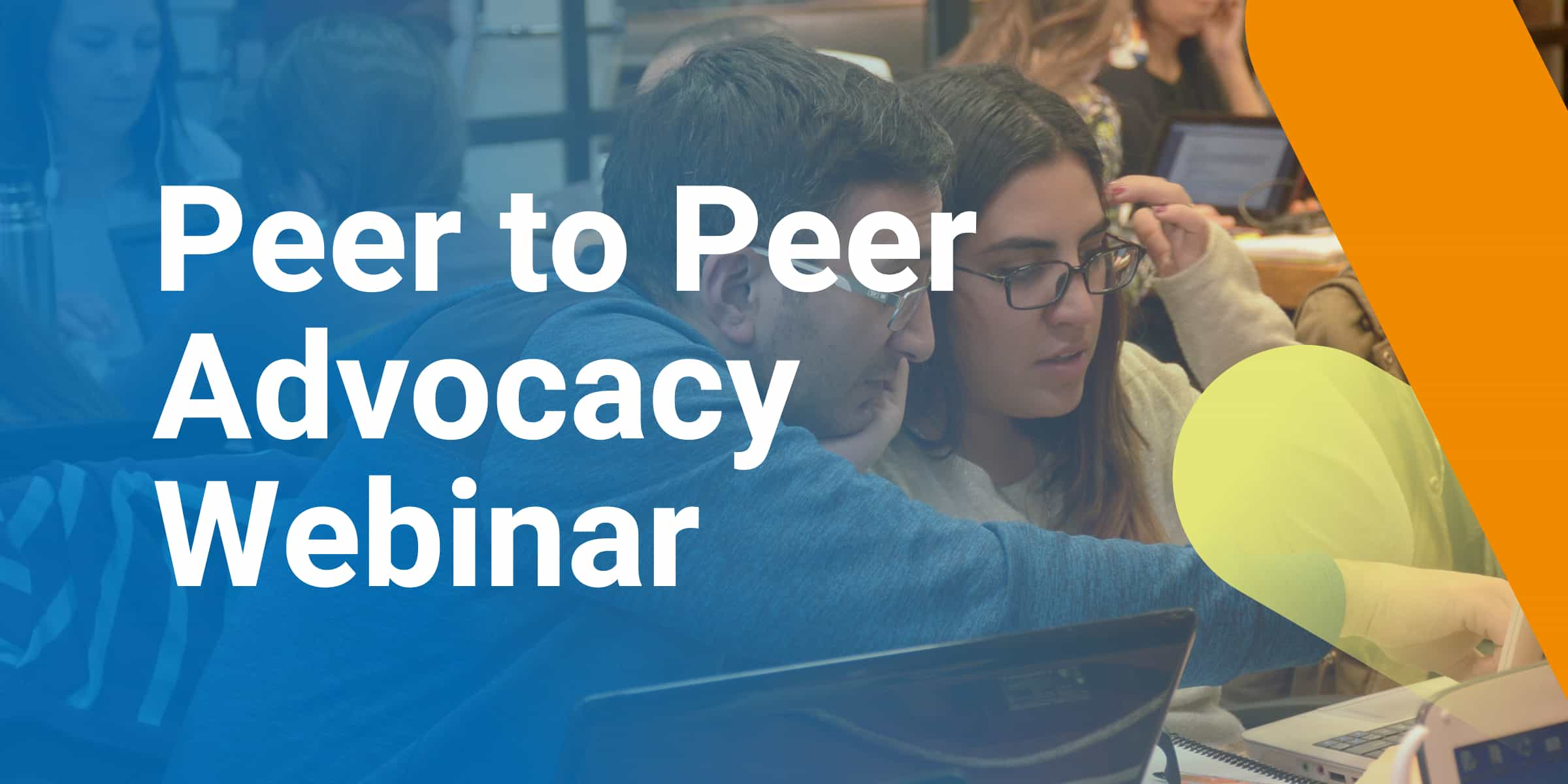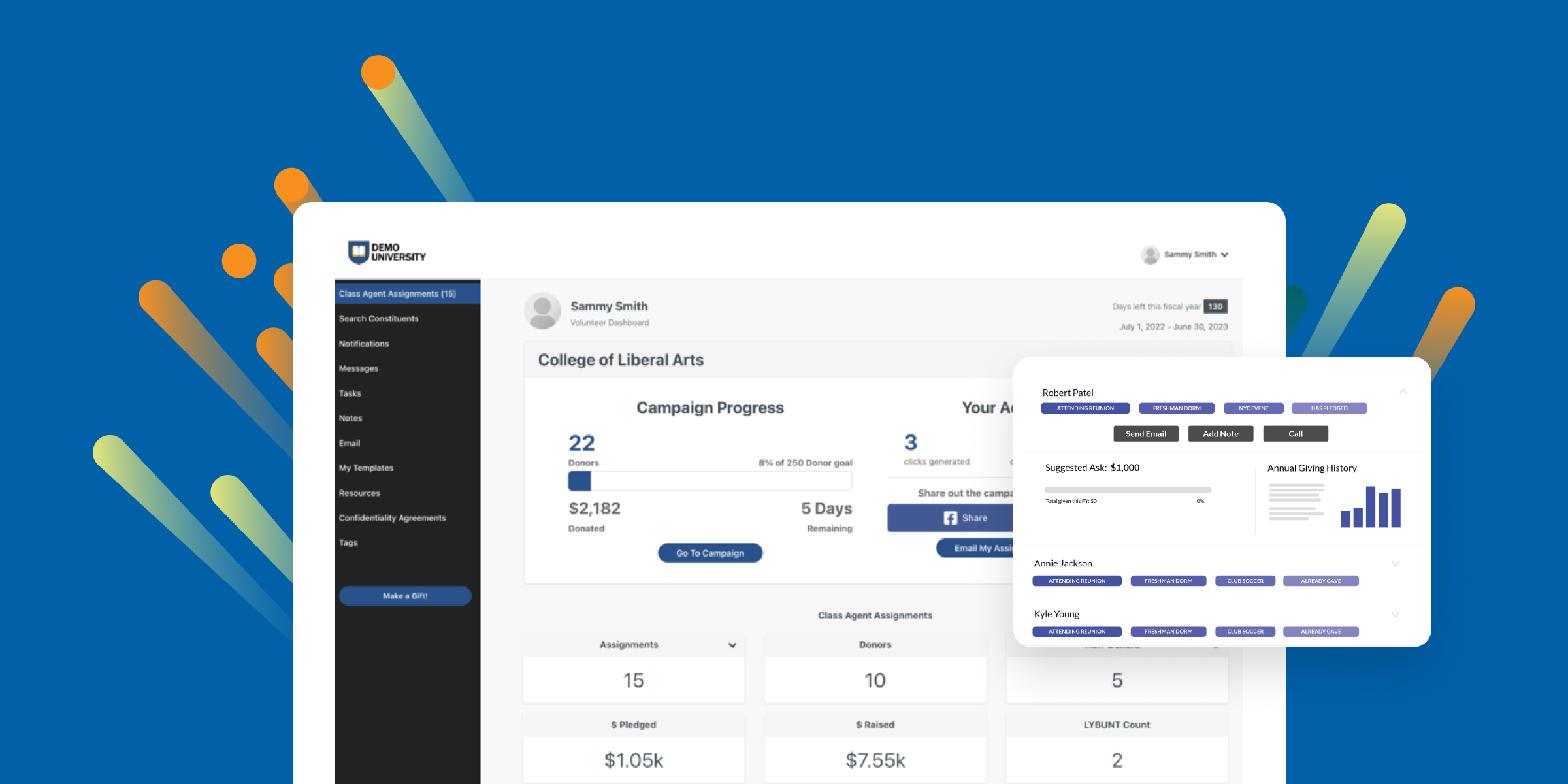Upgrade Your Year-Round Volunteer Engagement Strategies
Your institution’s advancement team may be small—but by mobilizing a network of engaged and motivated volunteers, you’ll be able to scale your team’s mission to meet even the loftiest fundraising goals.
To build a passionate force of volunteers, it’s essential to prioritize volunteer engagement not just during key fundraising events, but on a continuous basis. By building a year-round plan for mobilizing your volunteer groups, you’ll retain valuable and knowledgeable volunteers year after year, who will serve a crucial role in mobilizing donors and recruiting and training additional volunteers.
What is a volunteer engagement strategy?
A volunteer engagement strategy is an action plan to attract, mobilize, reward, and retain a committed base of volunteers who will support your advancement team in driving fundraising efforts to meet your institution’s financial goals. To build a successful volunteer engagement strategy, it’s important to consider each volunteer’s reasons for supporting your organization, and provide ongoing motivation and incentives to keep them committed to the cause. Your volunteer engagement strategy should focus on building a rewarding experience that enables individuals to advocate for the causes they care about, with opportunities to learn and grow within their roles and the chance to be recognized for their hard work.
Bates College, a prestigious liberal arts undergraduate college in Lewiston, Maine, has an active base of more than 550 alumni volunteers, who are responsible for completing more than 7,200 fundraising tasks within the school’s GiveCampus fundraising platform.
To mobilize their volunteer base, the Bates advancement team has implemented a comprehensive volunteer engagement strategy that outlines key goals and metrics at different intervals, and encourages frequent opportunities to engage with the school and their fellow volunteers throughout the course of the year—not just during fundraising drives.
Strategies to improve volunteer engagement
Nina Emmi ‘10, Senior Director of Annual Giving and Reunion, and Amy Jefferson, Senior Associate Director of Annual Giving and Reunion, recently shared their tips for recruiting and mobilizing a highly engaged volunteer alumni network at our annual GiveCampus Partner Conference (GCPC). Here are some of the top takeaways from their popular session.
1. Implement a quarterly volunteer management plan
Each quarter, the fundraising team at Bates focuses on building momentum towards a key “seminal moment,” with action items for volunteers to complete each month. Bates uses GC Volunteer Management to foster ongoing communications and to empower staff members and lead volunteers to set up and manage tasks for their respective networks, ensuring visibility and accountability within the platform.
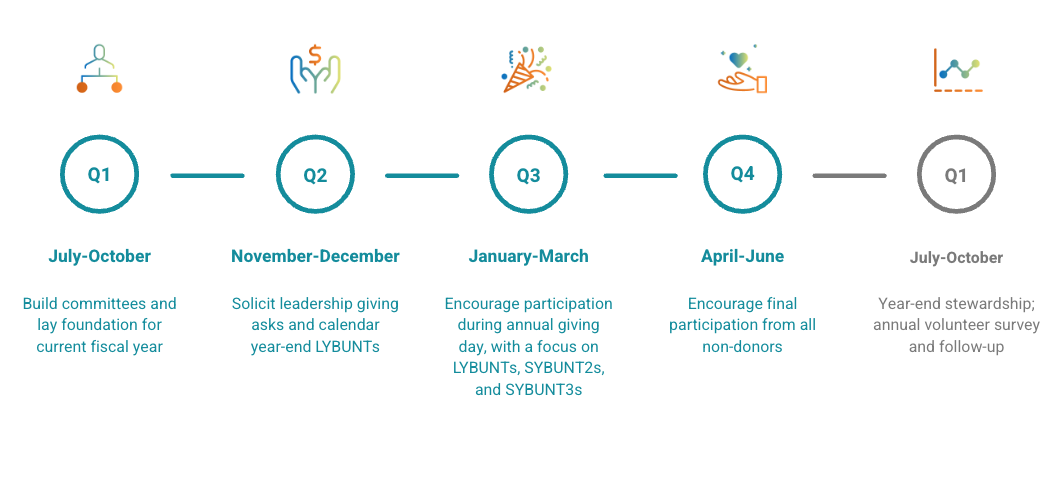
“There are some key periods during each quarter when we want to make sure our volunteers are super aligned,” says Jefferson. “Specifically, at the start of every month, we’re sending them an email saying, ‘here’s where you are. Here’s your progress to date. Here are your two to four action items.’”
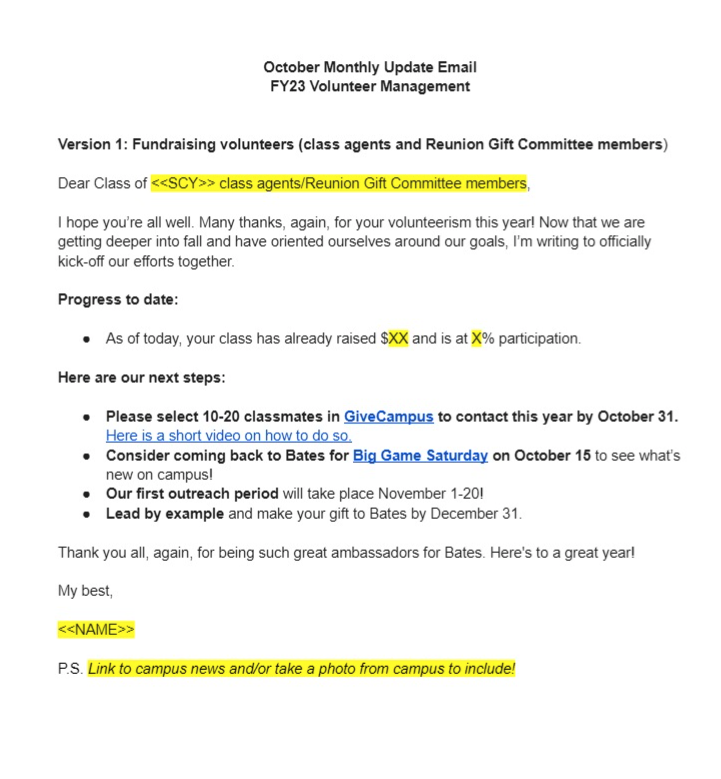
“We’re talking to them about Bates at least once a month,” adds Emmi, “asking them to do something for the college, whether it be attending an event, picking assignments, taking a survey. And then most importantly, we are always trying to remind our volunteers why they give and why they do the work. We call that ‘grounding it in the why.’ So we’re talking about our students, talking about the faculty, and centering their volunteerism in the mission of the college. And that’s been a big part of our retaining volunteers over time.”
And then most importantly, we are always trying to remind our volunteers why they give and why they do the work. We call that ‘grounding it in the why.’ So we’re talking about our students, talking about the faculty, and centering their volunteerism in the mission of the College. And that’s been a big part of our retaining volunteers over time.Nina Emmi Bates College
2. Segment your volunteers
Bates has a staff alumni liaison appointed for each graduating decade, who in turn oversees one or more “class managers” for each graduating year within that decade. Those class managers are responsible for reaching out to others from their graduating class with fundraising appeals and volunteer engagement opportunities. They’re encouraged to communicate with content that’s tailored to appeal to their peers—whether that includes mentioning a favorite class or historic event from their era, or refining the messaging to reflect the language of their generation.
Volunteers are also segmented based on their passions: Some might be interested in organizing their class reunion, while others are motivated to raise funds for specific groups, like the athletics department for example. By giving each volunteer the chance to work on committees with peers that share their passions, the Bates team drives community-building and gives volunteers the chance to mentor others.
3. Provide formal training opportunities
When a new volunteer signs up, a Bates team member makes the time to personally welcome them and walk them through the onboarding process.
“We don’t view recruiting and onboarding as scary or cumbersome, so we’ll welcome people on board at any time,” says Jefferson. The college offers a formal volunteer engagement training guide, but many volunteers prefer a more hands-on approach, and will receive training over Zoom or in person.
“We’re encouraging volunteers to use the volunteer management dashboard, and we’ve had great feedback from our GiveCampus partner to send them the link to log in even before they’re trained, and let them look around,” says Jefferson. “Half the time we’ve found that by the time we sit down and actually meet with the volunteer to train them, they say, ‘Oh, I’ve already gone in and picked my assignments.’ So then the training is only 10 minutes long.”
4. Promote peer-to-peer outreach
When it comes to soliciting donations and recruiting new volunteers, the lead agents for each class year are the school’s best assets.
“We connect with them all the time,” says Jefferson. “They know their class best. Direct emails from current volunteers to recruit their peers are the best-case scenario. So we’re always asking our volunteers, ‘do you know this person? Are you willing to reach out?’”
The lead agents also often give permission to use their names in the “from” line for emails and communications going out from the Bates advancement team to their graduating class. This leads to higher open and conversion rates from former classmates who are excited to see a message from a name they recognize.
“We also encourage agents to hold class-wide Zoom meetings,” says Jefferson. “Especially with reunion classes, they’re able to use the meetings to focus on getting their gift committees together, brainstorming ideas, and getting up to speed for the year ahead.”
5. Adopt GC Volunteer Management software to support your efforts
“We encourage all of our volunteers to use GiveCampus—which they love and have adopted at a very high rate—to make sure they have access to all the tools, templates, and guides we have for them,” says Emmi. “ And we reinforce that messaging in our monthly emails with our staff.”
The volunteer management dashboard provides all of the volunteers and staff members with clear action items and templates that they can use to execute on fundraising goals. For example, in Q3, the advancement team focuses on mobilizing volunteers to solicit funds from their graduating class in their “Great Day to Be a Bobcat” giving campaign.
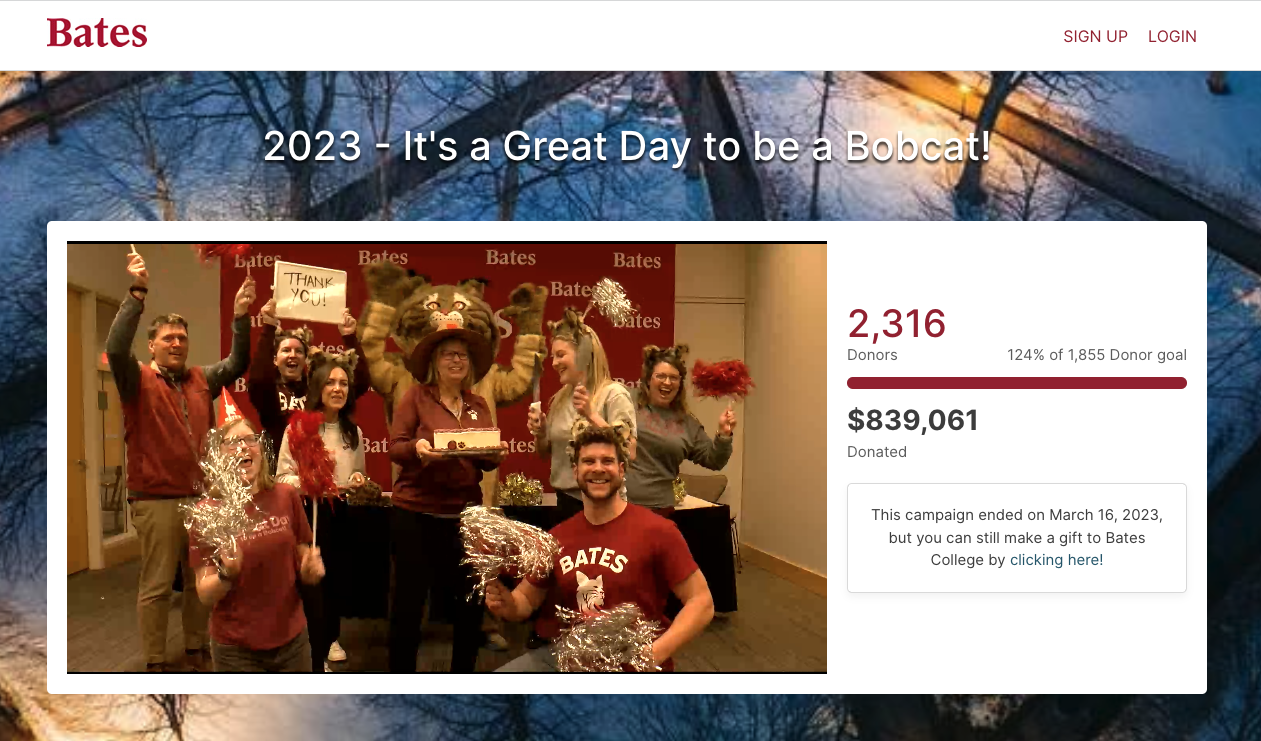
“Far in advance of our Giving Day, we reach out to every volunteer one-on-one and say, ‘out of your 20 or 30 assignments, here are the five that gave on Great Day last year. Please prioritize them,’” says Jefferson.
The advancement team provides instructions on logging in to the volunteer management portal to access the email template, then setting up a filter to narrow down the list to high-priority recipients. “Just trying to make it as easy and clear for our volunteers about what to do in that outreach period has seemed to work well,” Jefferson adds.
Volunteers are able to track their progress within the platform, with visibility as to which of their assignments has made a gift, so that they can reach out to thank them with a personal message. The platform also offers a volunteer leaderboard, so that volunteers can see how many dollars have been raised as a result of their advocacy—providing a gamified experience that encourages volunteers to “compete” against others to meet their goals.
6. Leverage year-end surveys
At the end of each major fundraising season once the school’s fiscal year ends, the advancement team sends out a survey, asking volunteers for feedback on their experience. They ask open-ended questions about what elements of the experience they liked, what they struggled with, and what recommendations they have for improving their volunteer management programs.
And they pay close attention to the data so that they can optimize the experience for their volunteer base for future fundraising efforts, ensuring that each volunteer gets a personalized experience that meets their goals.
“I’m passionate about following up,” says Emmi. “If you ask someone a question, you need to be prepared to act on the answer. So if someone tells us I’m uncomfortable volunteering, I’m overextended, I’m undervalued, we need to follow up in a timely manner. If they have feedback about the volunteer management platform, or an idea for us, for our volunteer program, or for the GiveCampus team, we’ll act on that and then tell them that we had that conversation with GiveCampus or we’re adjusting our plans this year.
“Follow up matters. It really is important. And I think that’s why our volunteers keep participating and keep taking our survey, because they know that when they take the time to give their feedback, we hear them and are going to act on it.”
Follow up matters. It really is important. And I think that’s why our volunteers keep participating and keep taking our survey, because they know that when they take the time to give their feedback, we hear them and are going to act on it.Nina Emmi Bates College
7. Show appreciation to your volunteers
Your volunteers are the lifeblood of your fundraising efforts–so make sure they feel appreciated, heard, and respected at every step along the way.
“Customer service is the most important to us,” says Jefferson. “We all are aligned and agree that we need to respond to our volunteers within 24 hours. If they ask us a question, even if we don’t know the answer, just letting them know, ‘I hear you, I’m working on it. I’ll get back to you as soon as possible,’ will build that trust. And then they’ll end up being more engaged in the long run.”
Jefferson also advocates “coming from a place of yes” in response to requests that can’t be fulfilled. “Instead of saying, ‘no, we can’t do that,’ say something like, ‘that might be challenging to do because of X, Y, Z, but have you thought about it this way?’ Or, ‘Oh, I love that idea you had. Can we explore that more?’ So really just coming from that place of yes and injecting some fun. These people are doing this out of the kindness of their hearts on top of busy careers, raising families, et cetera. So we want to make this fun.”
It’s also important to recognize and honor volunteers for their hard work. “We love sending shoutouts on larger group calls and in email campaigns, and sending gifts. Our volunteers love swag,” Jefferson adds. Some favorite volunteer incentives have included stainless steel straws, basil planters, marble coasters, and the chance to pick out any apparel from the campus bookstore.
“As fundraising guru Karen Osborne always says, ‘surprise and delight,’” Jefferson says. “That’s what we try to do.”
Summary
Bates College has built a holistic volunteer engagement strategy that leverages the GiveCampus platform to effectively collaborate with volunteers and incentivize them to meet fundraising goals. In so doing, they have been able to drive high rates of volunteerism and donations among their alumni base: 39 percent of school alumni actively participate in their fundraising efforts, driving more than $7.5 million in donations to the annual fund each year. The school is ranked one of the top 10 liberal arts schools for alumni participation.
The advancement team has excelled in creating a vibrant alumni network where constituents are passionate about supporting their school and mobilizing to support the causes they care about. With a focused volunteer engagement strategy that supports and honors their volunteers for their commitment on a year-round basis, the school has built a dedicated volunteer force that will continue to grow and drive value for the institution in the years to come.
Looking to improve your volunteer engagement strategy? Schedule a personalized demo to see GC Volunteer Management in action.


